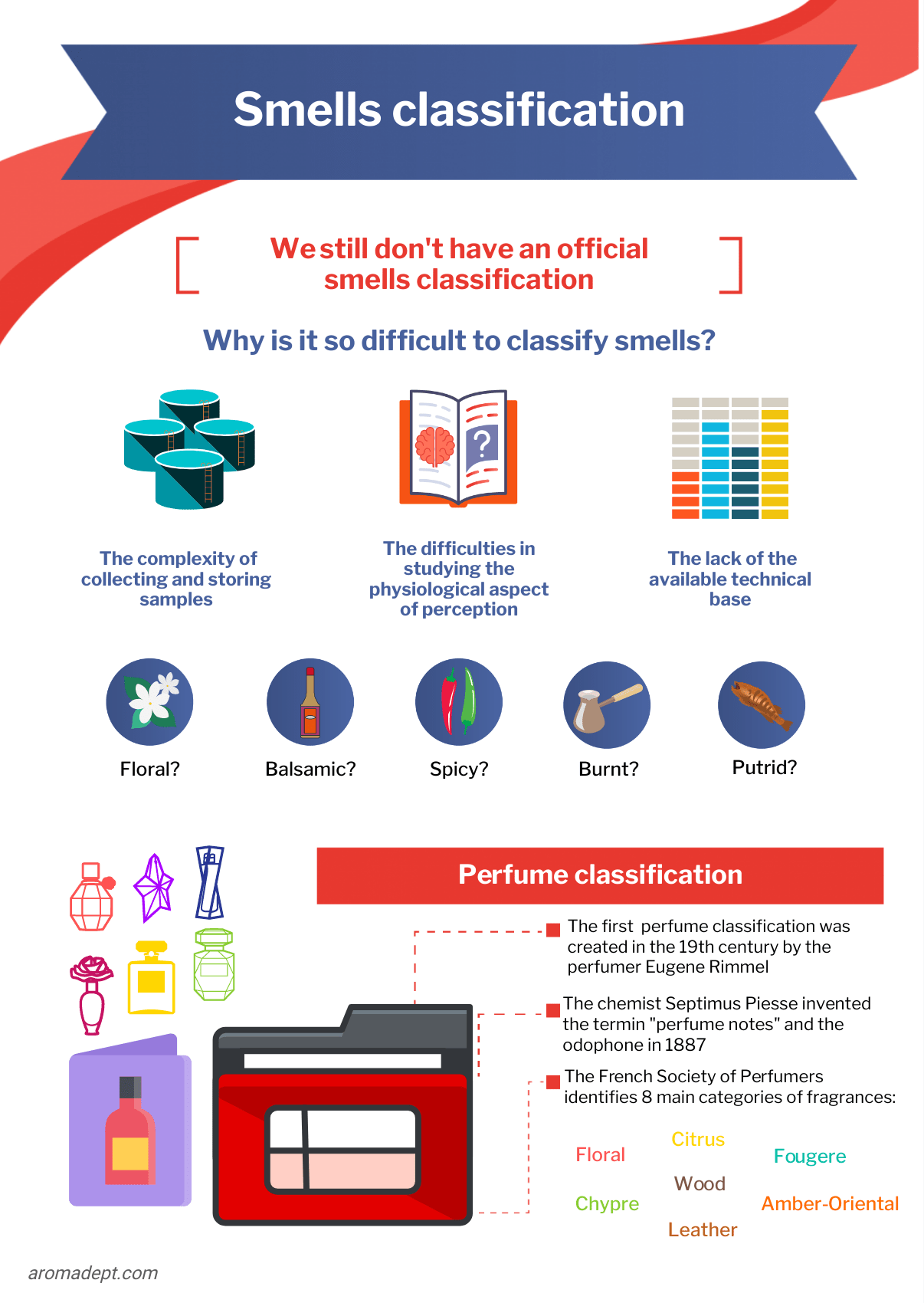
Classification of odors
Attempts to classify flavors were first made in the 18th century and continue to this day. Unfortunately, none of the proposed options fully cover the diversity of the world of smells.

In this section, the general classification of odors will be discussed separately from perfumes.
Basic classification of odors
- ⚈ Carl Linnaeus, 1765
- Aromatic (cloves, Bay leaves)
- Fragrant (lily, jasmine)
- Ambrosiac and musky (ambra and musk of animal origin)
- Onion/Garlic
- Goaty/fetid (valerian, dog)
- Repulsive (marigolds)
- Nauseating (pumpkin, carrion) odors
- ⚈ Hendrik Zwaardemaker, 1895
- Etherial (acetone, ether)
- Aromatic (spicy, camphor, anisic, citric, amygdalate / almond)
- Balsamic (flower, lily, vanilla)
- Amber-musk
- Alliceous (garlic)
- Empyreumatic / Burnt (roasted coffee beans, toasted bread)
- Hircine / Caproic acid (goat smell)
- Repulsive suffocating (some orchids, bugs)
- Nauseous (rotten meat)
- ⚈ Hans Henning, 1916 (the pyramid with six reference odors-categories)
- Fragrant/floral ( lavender, rose petals)
- Spicy (cinnamon)
- Resinous (resin)
- Ethereal (lether)
- Burnt (tar)
- Putrid (rotten meat, eggs)
- ⚈ Crocker and Henderson, 1927 (a scent is indicated by the odour four-digit number based on the intensity)
- Fragrant
- Acid
- Burnt
- Caprylic (goaty)
- ⚈ John Amoore, 1950s
- Camphoraceuos
- Ethereal
- Floral
- Musky
- Pepperminty
- Pungent
- Putrid
Perfume classification
The first perfume classification was created in the 19th century by the perfumer Eugene Rimmel, and it was based on floral and plant aromas.
One of the most complete systems of perfume classification is one that was developed by the French Society of Perfumers (La Société Française des Parfumeurs):
- ⚈ A. Citrus / Hesperides
- A1 Citrus
- A2 Citrus-spiced
- A3 Citrus-aromatic
- A4 Citrus-chypre-floral
- A5 Citrus-woody
- A6 Citrus-woody-floral
- A7 Citrus-musky
- ⚈ B. Floral
- B1 Mono-floral
- B2 Floral-musk
- B3 Floral bouquet
- B4 Floral aldehydes
- B5 Floral green
- B6 Floral-fruity-woody
- B7 Floral-woody
- B8 Floral-marine
- B9 Floral-fruity
- ⚈ C. Fougere
- C1 Fougere
- C2 Fougere-floral
- C3 Fougere-amber
- C4 Fougere-spicy
- C5 Fougere-aromatic
- C6 Fougere-fruity
- ⚈ D. Chypre
- Dl Chypre
- D2 Chypre-fruit
- D3 Chypre-floral-aldehyde
- D4 Chypre leather
- D5 Chypre-aromatic
- D6 Chypre green
- D7 Chypre-floral
- ⚈ E. Wood
- E1 Wood
- E2 Wood-citrus-coniferous
- E3 Woody-spicy
- E4 Woody-amber
- E5 Wood-scented
- E6 Wood-spice-leather
- E7 Wood-marine
- E8 Woody-fruity
- E9 Woody musk
- ⚈ F. Amber-Oriental
- F1 Soft/sweet amber
- F2 Floral-spicy-amber
- F3 Citrus-ambergris
- F4 Floral-woody-amber
- F5 Floral-semi-amber
- F6 Floral-fruit-amber
- ⚈ G. Leather
- G1 Leather
- G2 Floral leather
- G3 Tobacco and leather
See also:
Sense of smell and scents | Consumer culture of scents | The use of scents and getting rid of unpleasant odors